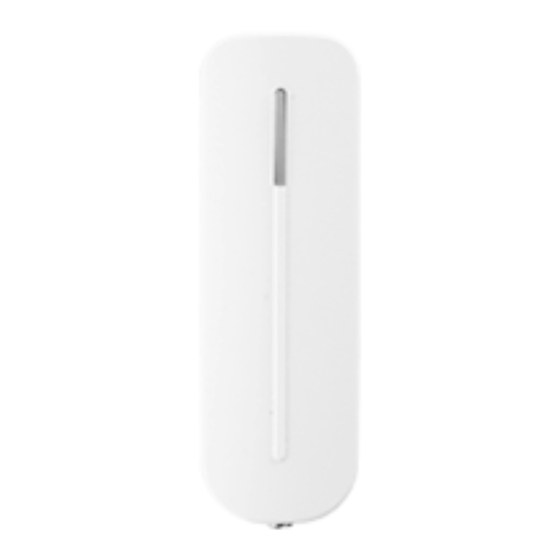
Table of Contents
Advertisement
Quick Links
Door Contact / Shock Sensor (DCSV-29)
DCSV-29 is a Door Contact / Shock Sensor that is capable of sending wireless signals to the Control Panel upon
detection of door/window opening or window glass break & shock detection.
The Door Contact / Shock Sensor design consists of a cover and base. The cover contains all electronics and the
base provides a means for fixing the device. An enclosed PCB tamper switch provides tamper protection against
unauthorized device opening and/or removal.
Parts Identification
1. LED Indicator / Test Button
- Press the button once to send a learn code or enter test mode for 3 minutes.
2. Cover Fixing Screw
3. Mounting Holes
4. Tamper Switch
- Provides tamper protection against unauthorized device opening and/or
removal from mounting surface.
5. Battery Insulator
6. Battery Compartment
7. Magnet
8. Magnet Screw hole
9. Magnet Spacer
Features
LED Indicator
In Normal Operation Mode, the LED will not light up when the device is activated.
When the device battery voltage is low, the LED will flash quickly when the device
is triggered.
When the tamper switch is triggered, the LED will flash quickly. When a tamper
condition persists, the LED will flash quickly whenever the device is triggered.
When under Test mode, the LED will flash quickly every time the device is
triggered.
When the battery is exhausted, the LED will flash every 4 seconds.
The LED will not flash if the device tamper and battery are normal and is not
under test mode.
If the LED flashes to indicate signal transmission, it will flash twice rapidly upon
receiving acknowledgement from panel.
Door Opening Detection & Shock Detection
The device is triggered by door/window opening or a shock detection which
exceeds detection threshold.
Materials of Mounting Surface
The device supports shock detection on various materials including glass,
wood, metal, and concrete. After installation, you can select the material of mounted surface on the Control
Panel.
Sensitivity
The sensitivity required to activate the Door Contact / Shock Sensor is determined from the Control
Panel.
Three sensitivity levels are selectable: Low, Medium, and High. The default is set as Medium.
Battery
The Door Contact / Shock Sensor uses one CR123 3V Lithium battery as its power source. The battery
1
Advertisement
Table of Contents

Subscribe to Our Youtube Channel
Summary of Contents for Climax Technology DCSV-29
- Page 1 Door Contact / Shock Sensor (DCSV-29) DCSV-29 is a Door Contact / Shock Sensor that is capable of sending wireless signals to the Control Panel upon detection of door/window opening or window glass break & shock detection. The Door Contact / Shock Sensor design consists of a cover and base. The cover contains all electronics and the base provides a means for fixing the device.
- Page 2 Set the Material & Sensitivity Level: 1. Press the Test Button on DCSV-29 for more than 3 seconds. The LED will turn on, indicating that the device is now under programming mode. (If no action within a 10-second timeout, DCSV-29 will automatically exit programming mode and return to Test Mode.)
- Page 3 3. When DCSV-29 receives programming command from the Control Panel, the LED will first turn off, and then turn brighter and turn dark. Material & Sensitivity level setting are now complete. Walk Test After the Door Contact / Shock Sensor is learned-in, place the Control Panel into (Walk Test) mode, ...
- Page 4 Mounting Procedure 1. Use the 2 mounting holes on back cover as template for positioning. 2. Use the provided wall plugs for window frames / concrete wall installation. 3. Screw the Door Contact / Shock Sensor into the wall plugs. (Drilling is recommended when mounting on steel, or you can also use the provided sticker in the package).
- Page 5 Federal Communication Commission Interference Statement This equipment has been tested and found to comply with the limits for a Class B digital device, pursuant to Part 15 of the FCC Rules. These limits are designed to provide reasonable protection against harmful interference in a residential installation. This equipment generates, uses and can radiate radio frequency energy and, if not installed and used in accordance with the instructions, may cause harmful interference to radio communications.








Need help?
Do you have a question about the DCSV-29 and is the answer not in the manual?
Questions and answers